Abstract
10 March 2020 was the moment that displayed the highest challenges within the Romanian educational system. A delicate educational system had to deal with the challenge of shifting all the educational programmes on the online environment which was an unexplored context for both teachers and students. Students’parents were also important educational stakeholders forced to adjust their activities to the pandemic situation. Organizational communication within educational institutions was deeply redesigned at both strategic and procedure levels. Being interested in the quality education, we intended to reveal through the present research the changes impact of the educational environment on the most important educational stakeholders (teachers), as well as the pandemic educational effects on students from the teachers’ point of view. The research considers a comparative analysis through a sociological survey based on questionnaire applied to teachers from four educational levels: early education, primary education, secondary lower education or gymnasium and superior secondary education. The research aims to reveal the changes within the educational communication pattern, as well as the communication barriers. The research intends to report which educational students’ skills were advantaged or disadvantaged during the pandemic. The reasearch outcomes may outline the opportunity for further research in the educational communication domain, post-pandemic educational context being of high interest.
Keywords: Educational communication pattern, education, online communication pattern, pandemic
Introduction
Pandemic educational context
Increasing number of Covid-19 infections forced Romanian authorities to declare the state of emergency, public interactions being extremely limited. Moreover, the educational institutions were closed and the teaching activities unexpectedly shifted to the online environment. In addition, school closure during the pandemic affected a high percentage of students all around the world.
Although all educational stakeholders wanted and needed to come back to the classic face-to-face courses, during the pandemic they all faced up the sudden adjustment to the new conditions. Digital skills acquisitions were emphasised during this period. Still, numerous educational contents were not taught and some important improving programmes were completed. It was thought that educational standards and goals may still be achieved, so efforts were made to implement remedial programmes in order to recover untaught educational contents (Rodideal & Marinescu, 2021).
The crisis generated by the pandemic had important effects in all fields of activity, including social services, such as children care and education. Accordingly, some legislation related to parents’ leave was adopted in order to facilitate access to online education for all children (Institutul de Cercetare a Calității Vieții. Academia Română, 2020).
The educational system was also affected by the pandemic. Replacing educational activities, redesigning the whole educational process and continuous legislation modifications during the pandemic brought some disorders within the whole educational system.
Educational Communication
Referring to educational communication, the second semester of the school year 2019 – 2020 brought significant challenges for the whole educational Romanian system. Teachers and managers had to identify solutions for a proper communication with students and parents in order to continue learning. Online education was little used before in Romania, so the start was difficult for both teachers and students. Moreover, many categories of students from vulnerable environments didn’t have access to online education because digital devices and internet connection weren’t accessible.
Shifting the educational process to online environment brought numerous inequalities as many vulnerable categories of students had deficiency of digital resources and skills, student categories originating from rural areas or arising from low-income families and from ethnic minority families being the most affected. Education inequalities were also the result of teachers’ deficiency of digital resources and skills. Digital training programmes were launched, but they weren’t as effective as a constant long-term learning process.
Accordingly, the fundamental right to education in terms of accessibility should be addressed. We also refer to educational communication process, the adapted curriculum to the pandemic situation, the educational design process, methodology and types of communication relations in schools. Zamfir and Cace (2020) outline that the educational system and communities were helpless despite the power of the new digital technology.
The present research will analyse which type of communication relations were affected. Some communication relation types were chosen due to the frequency of use in the educational process: teachers – students, teachers – parents, teachers – manager, students – students, teachers – teachers, teachers – local authorities. The communication channel is also of high interest as it changed during the pandemic. Therefore, a new educational communication pattern will be created and analysed. Additional research problems will consider the communication barriers and the enhanced or ignored students’ skills during the pandemic.
Educational communication pattern
Communication is a dynamic process based on social interaction, being an important requirement for human existence (Dinu, 2021). One of the most famous communication patterns is Shannon Weaver (1949) which was illustrated in 1949, using mathematical theories to explain the linear process. The model included: a source of information, a transmitter, a channel, a receiver and an information destination. Other authors (Berlo, 1960; Schramm, 1954) added some new features, such as encoding, decoding, noise and feedback. Lasswell’s model (Chandler & Munday, 2011) also brought important contributions.
Related to these communication models, we display the following educational communication pattern according to the traditional teaching process.
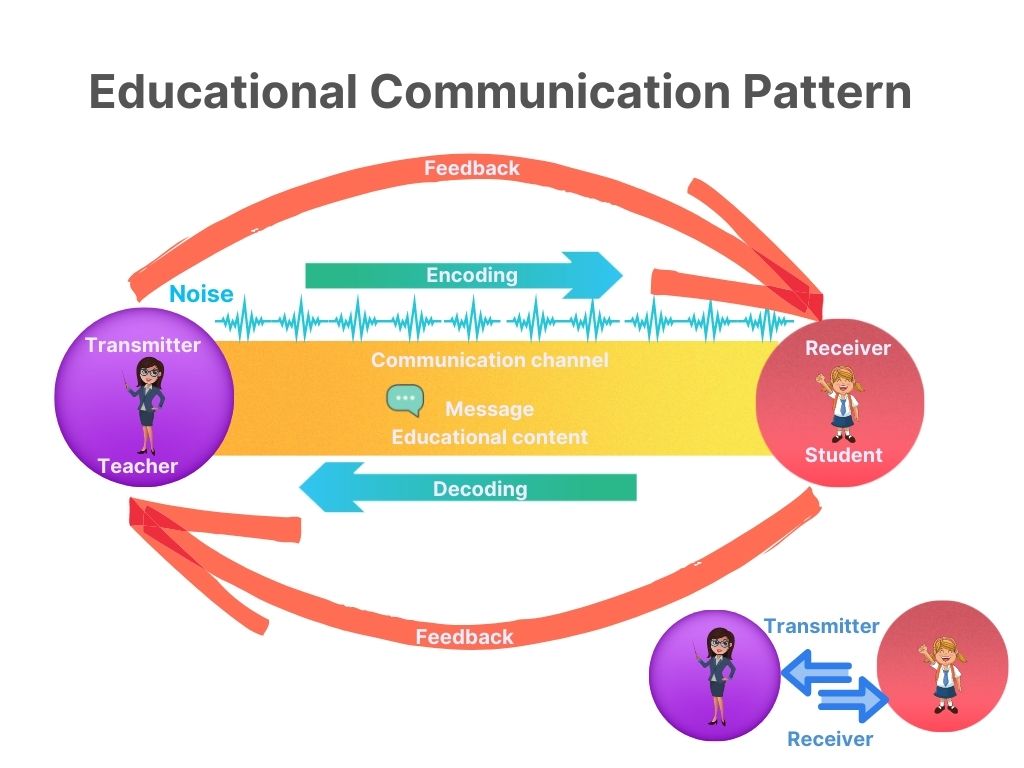
The educational communication pattern (figure 1) above consists of a transmitter as a teacher and a receiver as a student or students. They can swap roles any time during the teaching process in a two-way communication model. The pattern also includes a communication channel and information which is, in fact, educational content that can be expressed as any educational means contributing to achieve the educational goals. There can be noticed the noise that can impede the teaching process. Encoding and decoding are also important as they assure the appropriate information perception from the two sides. Feedback is the most important feature of the pattern as it allows adjusting information from both teacher’s and student’s points of view.
Online educational communication pattern
Online teaching activity had some changes reported to the traditional educational process and, accordingly, the educational communication modified within the online framework. Consequently, in connection with the above presented pattern, we suggest the following online educational communication pattern.
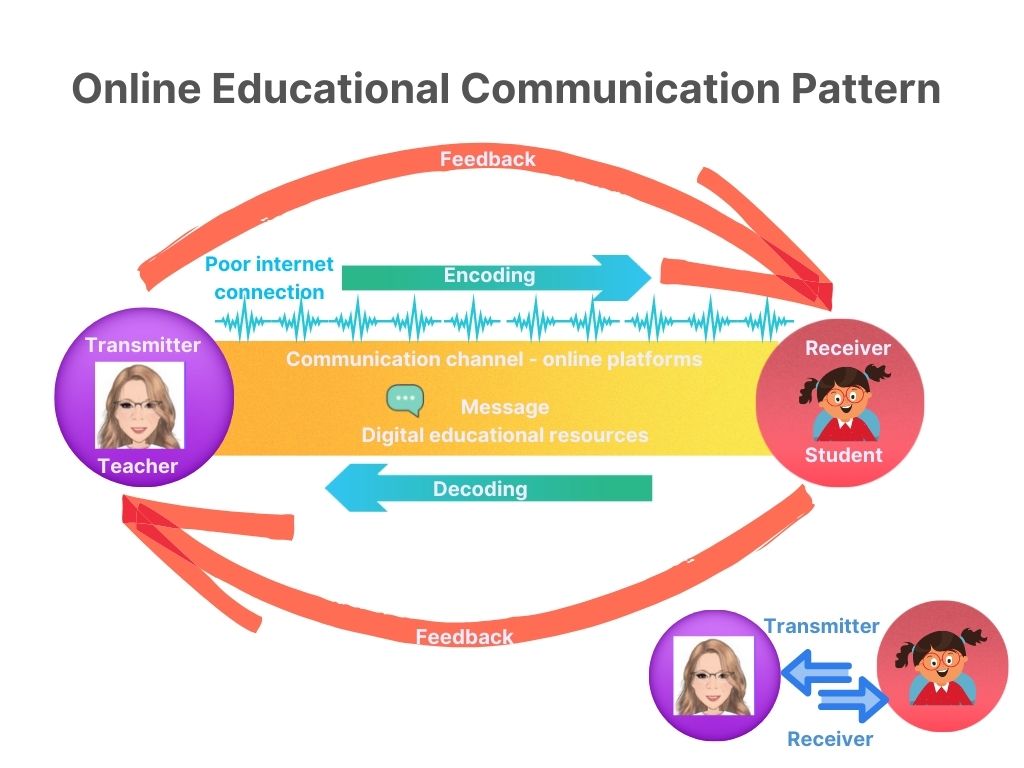
The present online educational communication pattern (figure 2) considers a transmitter and a receiver, as teacher and students, swapping roles as often as needed. Even if teachers manage all the educational process, students and teachers may appear as having `equal positions` in communication in the online context. The communication channel relies on online platforms while the information is still educational content, but expressed by digital educational resources. While communicating, poor internet connection or other sounds in the room can interfere and impede understanding the information. Encoding and decoding are still essential features that enable properly perceiving the information. Feedback is still the most important feature in the communication process, but it appears to be inaccurately perceived as less stimuli are involved.
Online communication barriers
Communication barriers reveal important concern in all fields, including education, as understanding them properly can lead interlocutors (teachers and students) to an efficient communication process. While some authors (Oke et al., 2021) show interest in educational communication barriers within families, identifying five boundaries: attitudinal, cultural, structural, welfare and environmental, others (Klimova & Semradova, 2012) highlight different communication barriers, such as cultural and national differences, type of thinking, paradigm of rationality, professional difference, age difference, experiential and knowledge difference.
Online educational communication can reveal some specific barriers, as noticed during the pandemic: deficiency of devices or internet connection, students’ digital skills, teachers’ digital skills, parents’ digital skills (for ECEC students or other student categories that needed assistance).
Enhanced educational skills during the pandemic
Taking into consideration the educational skills developed during the pandemic, we should draw attention to changing structure of students’ skills in order to reconsider further teaching design process in pandemic context. Intensive analysis on students’ skills acquisition should be conducted based on evaluating the educational process during this period.
Related to students’ skills, Eurydice reports (European Commission. Eurydice, 2021) illustrate the Romanian student profile based on the following key-competences: communication in mother tongue, communication in foreign languages, mathematics skills and basic skills in science and technology, social and civic skills, digital competence, initiative and entrepreneurship, learning to learn and cultural awareness and expression.
Considering the enhanced educational skills during the pandemic, there should be a high expectation on digital skills. As noticed, all educational stakeholders, including teachers, students and parents improved their digital skills forced by the shift to the online learning.
Problem Statement
Being interested in educational communication during the pandemic, we focused on three issues considered to be important for enhancing the whole educational process.
Firstly, we focused on the educational communication pattern, trying to notice model changes during the pandemic. We presumed that the educational communication model had changed during the pandemic, the educational content in shape of educational digital resources being the most important modification.
Secondly, we concentrated on the online communication barriers within the educational process, noticing particular limits and ways to overcome them. Assuming that the essential communication barrier was the lack of digital skills for both teachers and students, we predicted that the most frequent way to overcome this problem was self-teaching.
Last, but not least, another important issue considered the enhanced students’ skills, as well as the ignored ones during the pandemic online classes. We presumed that digital skills and learn how to learn skills were obviously the most encouraged to develop while socio-emotional skills were ignored in the pandemic educational context.
We conducted our research being interested in the most important educational stakeholders’ point of view – teachers. We chose teachers from the same geographical area, which is Argeș county. We intended to reveal a comparative analysis of educational communication during pandemic within four educational levels – early education, primary education, secondary lower education or gymnasium and superior secondary education – through a sociological survey based on questionnaire.
Therefore, we selected 19 questions organized on three sections: Data about educational communication during the pandemic, Data about professional status and Socio-demographical data. The first section consists of 11 questions offering data about the most affected communication relationship type, ways of organizing classes, meetings with parents and extracurricular activities, online communication barriers, changes within the educational communication pattern, enhanced and ignored students’ skills during the pandemic. The last two sections offering data about professional status and socio-demographical data contain 4 questions each. After applying the questionnaire, 69 answers resulted as presented in the following sections.
Research Questions
After identifying the research problem, we focused on three main research questions supporting our study. Answering the first question, we take into consideration the new online educational communication pattern, identifying the most important changes from the teachers’ point of view.
The second question should reveal important particular online communication barriers during the pandemic. Efficient ways of surmounting the communication problem should be disclosed.
Having known the enhanced and ignored students’ skills during the Covid-19 pandemic period, how can the educational system be improved? is the third research question that should express important feedback about progress and regress within the online educational process.
Purpose of the Study
The present study intends to support quality education through expressing important data on educational communication during the pandemic. An important contribution is displayed by The Online Educational Communication Pattern which is the authors’ sketching and enables understanding the changes implied by the online teaching. Understanding the new pattern and identifying the most important changes from the teachers’ point of view stress the need of focusing on these important changes, such as prevalence of digital educational resources in order to provide high quality education.
Moreover, understanding and identifying the particular online educational communication barriers enable practitioners and decision makers guide educational process in the right direction, overcoming all possible problems. Identifying potential ways of surmounting problems supports reinforcing the right solutions and testing new ones.
In addition, the analysis of the enhanced and ignored students’ skills during the Covid-19 pandemic period provide valuable feedback for practitioners and decision makers. The collected information should enable educational stakeholders organize further efficient educational programmes.
Research Methods
After identifying the research problems and questions, the team continued conducting the quantitative research by applying the questionnaire on the chosen subjects – the most important educational stakeholders – teachers. The survey subjects were chosen from the four educational levels – early education, primary education, early education, primary education, secondary lower education or gymnasium and superior secondary education, working in the same geographical area in Romania. 69 answers resulted out of the questionnaire application.
Collected answers were exported on Excel data basis. Using specific Excel formulas, correlations were made between questions related to the new online educational communication pattern and educational levels. There were also performed correlations between questions related to communication barriers and educational levels. However, comparative analysis on educational levels was not conclusive as collected results were similar. Therefore, global result analysis was performed. Nevertheless, comparative analysis on educational levels was accomplished for collected information related to enhanced students’ skills, revealing also the ignored ones.
Findings
Consequent to conducting the present study, the team disclose important findings for educational communication domain as presented in the following graphics.
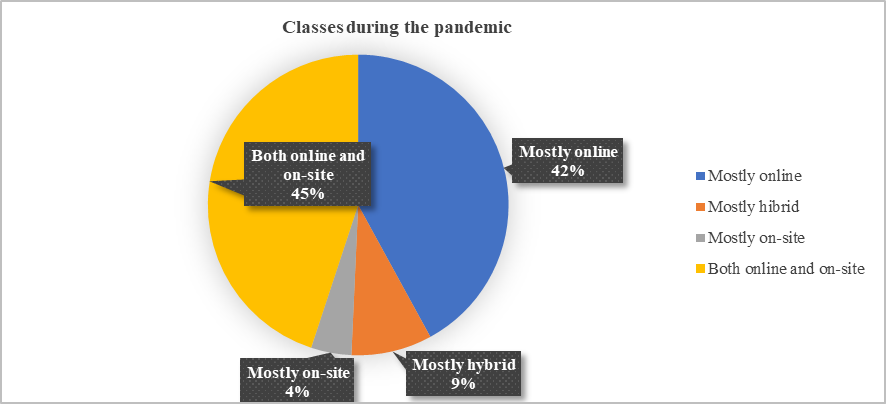
As exposed in Figure 3, classes were performed both online and on-site in 45% of obtained answers and mostly online in 42% of situations during the pandemic. A low percentage (4%) represents traditional classes and 9% are hybrid classes. These results disclose the importance of online educational communication, this type of communication being used massively.
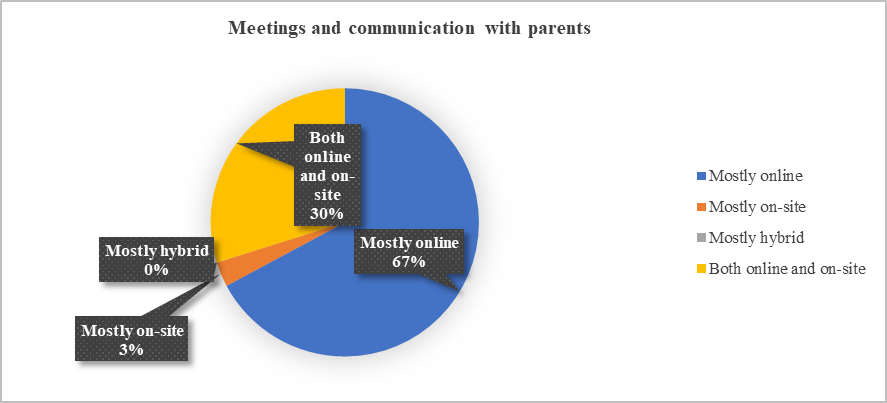
Meetings and communication with parents, as pointed in Figure 4, were organized mostly online (67%). In 30% of situations, there were both online and on-site meetings while only 3% of activities were held mostly on-site. There weren’t any hybrid activities with parents.
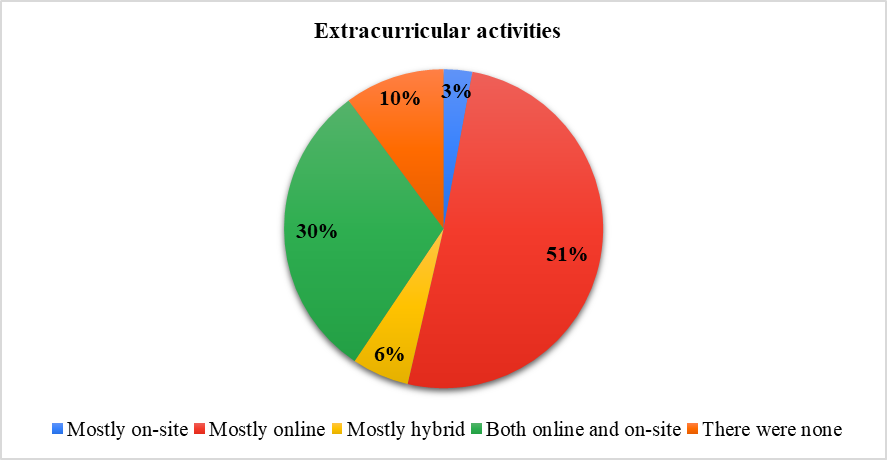
As expected, extracurricular activities (Figure 5) were organized mostly online during the pandemic in 51% of the answers. Still, 30% of extracurricular activities were held both online and on-site, 6% were mostly hybrid and only 3% of them were mostly on-site. A negative aspect of the pandemic is illustrated by 10% of situations where extracurricular activities were not carried out at all.
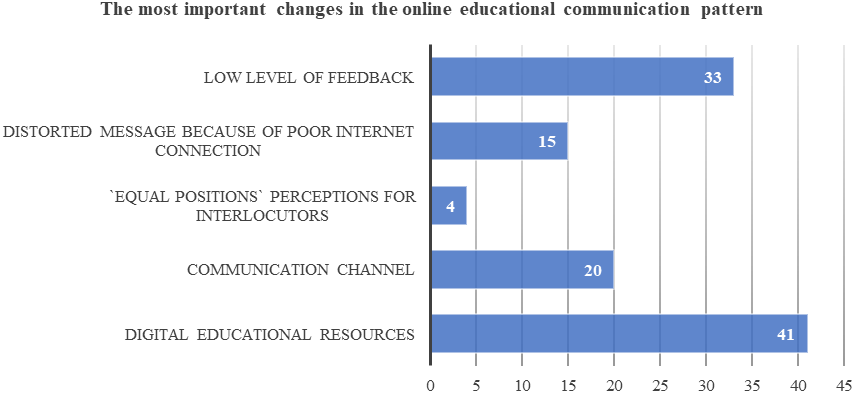
The most important changes interfering in the online educational communication pattern are digital educational resources (41 answers) and the low level of feedback (33 answers) in the teachers’ point of view, as revealed in Figure 6. The lowest value (4) refers to `equal positions` perception for students and teachers within the online framework. Communication channel is considered to be an important change, online platforms having impact on 20 of the respondents. 15 answers took into consideration distorted message because of poor internet connection as an important change in the online educational communication pattern.
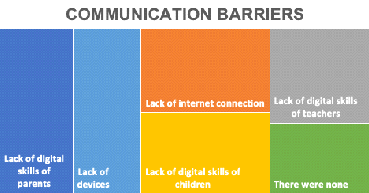
Referring to online communication barriers, we revealed lack of internet connection, lack of devices, lack of teachers’ digital skills, lack of students’ digital skills and lack of parents’ digital skills as particular limits (Figure 7). For the last communication barrier, we considered early education students’ parents or other student categories that needed assistance during the online classes. All the barriers have similar values related to the number of answers, varying between 23 (lack of teachers’ digital skills) and 29 answers (lack of parents’ digital skills). There were also 17 answers sustaining that there weren’t any communication barriers, which is a positive aspect.
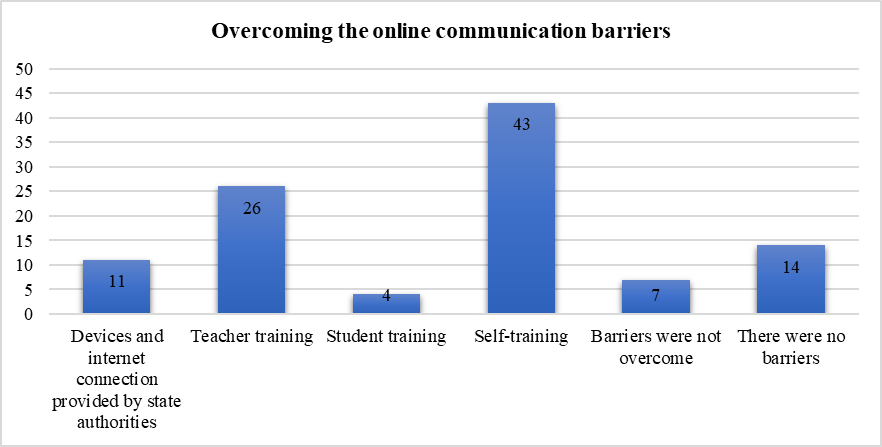
Ways of overcoming the online communication barriers are expressed in Figure 8. The highest value of answers refers to self-training (43). Teacher training was also an important option to surmount the problem, counting 26 answers. Student training had the lowest value (4), meaning that there were not organized numerous courses for students. Solutions were also given by state authorities when providing devices and internet connection (11). There were 7 situations when barriers were not overcome and 14 answers claiming not having any communication barriers during the pandemic.
The enhanced students’ skills are displayed in Table 1 correlated with the educational levels. At the same time, ignored skills during the pandemic are revealed. As expected, all teachers from all educational levels believe that digital skills were the most developed skills while physical development skills were the most neglected ones during the pandemic classes, the last category of skills getting no answer at all educational levels.
Early education teachers claim that digital competences and learning how to learn skills were advantaged, obtaining 19 and 14 answers, while physical development skills were overlooked. As mentioned, all the teachers agree with the same enhanced skills during the pandemic. Consequently, digital and learning how to learn skills were considered to have been privileged during the pandemic, each of them getting different values according with the number of teachers answering for every educational level: 18 and 10 answers (primary teachers), 10 and 8 (gymnasium teachers), 9 and 7 (superior secondary education teachers).
Referring to undervalued skills during the pandemic, primary teachers indicated physical development (0), socio-emotional development (1), language development (1) and developing the spirit of initiative and entrepreneurship (1) as being disadvantaged. On the contrary, gymnasium teachers believe that cognitive development (1) were neglected at the same time with physical development (0) and socio-emotional development (1). Superior secondary teachers claim that developing the spirit of initiative and entrepreneurship (0), physical development (0), socio-emotional development (1) and language development (1) were disadvantaged during the pandemic.
Conclusions
Educational systems all around the world were affected by the pandemic. Shifting all the educational process to online implied numerous changes and a lot of flexibility. Teachers and students had to continue teaching and learning, integrating the new experience in the old structures. Adapting to changes was the expected and the essential feature for both teachers and students.
As the whole teaching process changed, the communication model also modified. We should mention that important contributions to education and communication domains are The Online Educational Communication Pattern displayed in the present paper, as well as the results of the conducted study.
The present paper explained how the educational communication pattern changed within the pandemic framework, adding valuable information related to important changes, as noticed by teachers. Shifting to digital educational resources was the most important change, as well as the low level of feedback provided within the online activities. Understanding the new pattern and identifying the important changes enable the educational stakeholders choose the right strategy for high quality online education.
Moreover, the study revealed online communication barriers and ways to overcome them. Communication barriers in the new framework consisted of lack of devices, lack of internet connection, lack of teachers’ digital skills, lack of students’ digital skills and lack of parents’ digital skills. An interesting finding is that the best way to overcome the barriers was the self-training. Teacher training was also an efficient option. Identifying the barriers and the ways to overcome them offers the right solution in case of similar situation.
In addition, noticing the enhanced and ignored skills during the pandemic enables educational stakeholders make the right decisions regarding remedial activities. Having noticed that physical development and socio-emotional development were overlooked during the pandemic, essential decisions should be made by all the teachers. When starting on-site classes, teachers should pay more attention to these skills. At the same time, they should continue to improve the skills advantaged during the pandemic, such as digital skills and learn how to learn skills.
The present paper should bring important contribution to education and communication domains, drawing the directions for a continuous and efficient educational process. Information provided is important feedback that enables teachers adjust their activities to the new situation. This paper can lead to further research, post-pandemic framework being of high interest.
References
Berlo, D. (1960). The process of communication. An introduction to theory and practice. Holt, Rinehart and Winston.
Chandler, D., & Munday, R. (2011). A Dictionary of Media and Communication. Oxford University Press.
Dinu, M. M. (2021). Studiu privind impactul formei de învățământ în mediul online [Study on the impact of the education in online environment]. Career counseling and guidance center. University of Pharmacy and Medicine from Craiova.
European Commission. Eurydice. (2021). Eurydice. Romania. Teaching and learning in general upper secondary education. European Commission. https://eacea.ec.europa.eu/national-policies/eurydice/content/teaching-and-learning-general-upper-secondary-education-49_en
Institutul de Cercetare a Calității Vieții. Academia Română [Quality of Life Research Institute. Romanian Academy]. (2020). Raport social al ICCV Mai 2020. Stare de urgență pentru consumul populației [Special report of ICCV, May 2020. Emergency state for population consumption]. Academia Română.
Klimova, B. F., & Semradova, I. (2012). Barriers to communication. Procedia - Social and Behavioral Sciences, 31, 207-211. DOI:
Oke, A., Butler, J. E., & O’Neill, C. (2021). Identifying Barriers and Solutions to Increase Parent-Practitioner Communication in Early Childhood Care and Educational Services: The Development of an Online Communication Application. Early Childhood Education Journal, 49(2), 283-293. DOI:
Rodideal, A., & Marinescu, V. (2021). Efectele pandemiei Covid-19 asupra sănătății și stării de bine a copiilor [The effects of Covid-19 pandemy on health and well-being of children]. Revista română de sociologie, 1-2, 57 – 84. https://www.revistadesociologie.ro/content/nr-1-22021
Schramm, W. (1954). How communication works. The process and effects of communication. University of Illinois Press.
Shannon, C., & Weaver, W. (1949). The mathematical theory of communication. University of Illinois Press.
Zamfir, C., & Cace, S. (2020). Covid 19 în România. Date, evoluții, analize și statistici [Covid 19 in Romania. Data, analisys and statistics]. Editura Expert, 101. DOI:
Copyright information

This work is licensed under a Creative Commons Attribution-NonCommercial-NoDerivatives 4.0 International License.
About this article
Publication Date
10 April 2023
Article Doi
eBook ISBN
978-1-80296-961-0
Publisher
European Publisher
Volume
5
Print ISBN (optional)
-
Edition Number
1st Edition
Pages
1-1463
Subjects
Education sciences, teacher education, curriculum development, educational policies and management
Cite this article as:
Lazăr, M., Postelnicescu, C. G., & Sitea, D. M. (2023). Changing Educational Communication Pattern During The Pandemic. In E. Soare, & C. Langa (Eds.), Education Facing Contemporary World Issues - EDU WORLD 2022, vol 5. European Proceedings of Educational Sciences (pp. 933-945). European Publisher. https://doi.org/10.15405/epes.23045.93

